Unlock the secrets to consistent profitability with our comprehensive guide on long term forex trading strategy.

Imagine waking up each day without the relentless pressure of tracking minute-to-minute market fluctuations, yet still reaping substantial profits. This is the reality for traders who master a long term forex trading strategy. In the volatile world of forex, where short-term trading often leads to high stress and unpredictable outcomes, long-term trading offers a disciplined, strategic approach focused on sustained growth. Partnering with a reliable regulated forex broker ensures you have the right tools and support to implement these strategies effectively. This article provides valuable and practical insights into developing a successful long-term forex trading plan, covering everything from foundational concepts to advanced strategies.
Definition of Long-Term Trading
Long-term forex trading strategy involves holding positions for extended periods, typically weeks, months, or even years. Unlike short-term trading styles such as day trading or scalping, which aim to exploit minute price movements within minutes or hours, long-term trading focuses on macroeconomic factors and fundamental analysis to make informed decisions. The goal is to benefit from substantial shifts in currency values over time, leading to more stable and predictable returns.
Key Differences Between Long-Term and Short-Term Trading
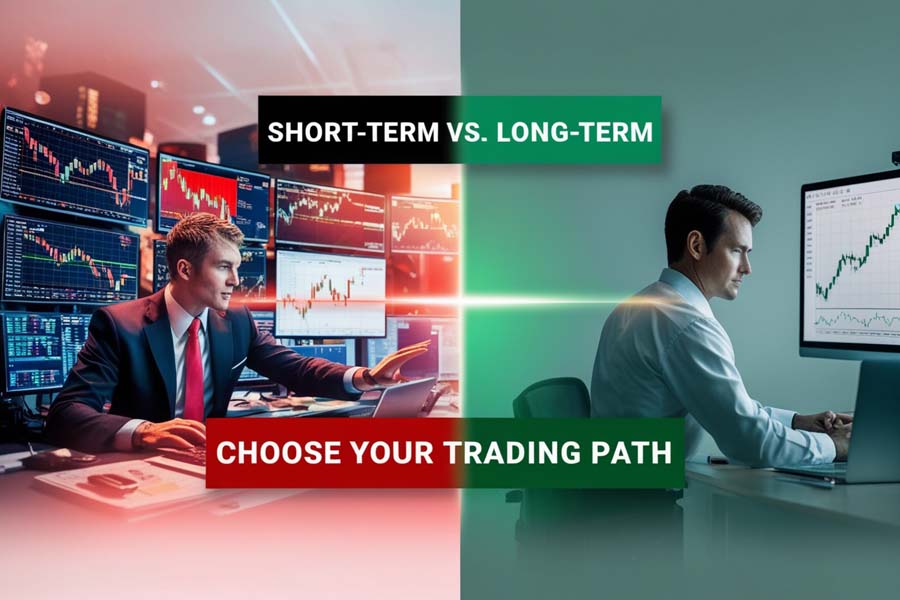
Understanding the distinctions between long-term and short-term trading is crucial for selecting the strategy that best aligns with your goals and lifestyle:
- Time Horizon:
- Long-Term: Positions are held for weeks, months, or years.
- Short-Term: Positions are held for minutes, hours, or days.
- Analysis Focus:
- Long-Term: Emphasizes fundamental analysis, economic indicators, and geopolitical events.
- Short-Term: Relies heavily on technical analysis, chart patterns, and market sentiment.
- Trading Frequency:
- Long-Term: Fewer trades with larger potential gains per trade.
- Short-Term: High frequency of trades with smaller gains per trade.
- Stress Levels:
- Long-Term: Generally lower stress due to less frequent monitoring.
- Short-Term: Higher stress from the need for constant attention and quick decision-making.
Emphasizing the key differences helps traders choose the approach that best suits their risk tolerance and lifestyle.
Read More: Trend Reversal Trading Strategy
Benefits of Long-Term Forex Trading
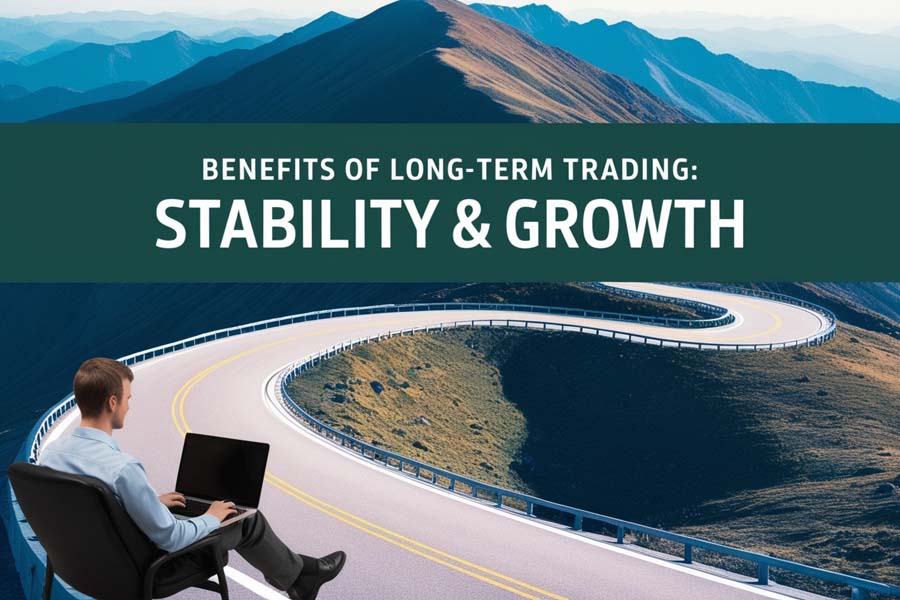
Adopting a long term forex trading strategy offers numerous advantages that can enhance your trading experience and profitability:
Reduced Stress Compared to Short-Term Trading
Long-term trading alleviates the constant pressure of monitoring the markets every few minutes. By focusing on broader trends, traders can maintain a more relaxed and disciplined approach, minimizing the emotional rollercoaster often associated with short-term trading.
Potential for Larger Profits
While short-term trading can yield quick gains, long-term trading capitalizes on significant market movements driven by fundamental factors. This strategy often leads to more substantial and sustainable profits over time.
Less Time-Consuming
Long-term traders do not need to spend hours analyzing charts or executing trades throughout the day. This approach allows for a better work-life balance, making forex trading a viable option even for those with busy schedules.
These benefits make long-term trading an attractive option for traders seeking stability and consistent growth.
Read More: Trading Strategies for Commodities
Key Components of a Long-Term Forex Trading Strategy
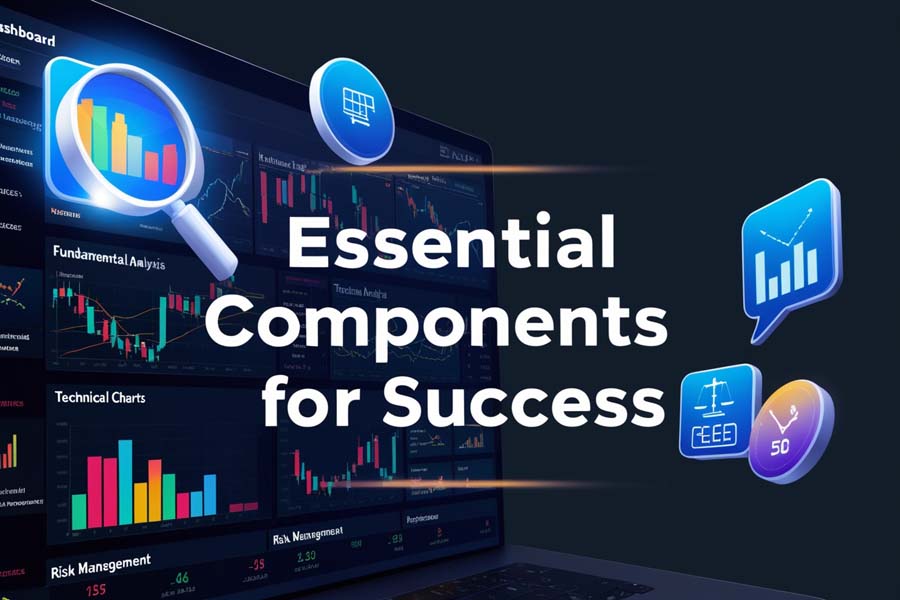
Developing a robust long term forex trading strategy involves several critical components that work together to ensure consistency and profitability.
Fundamental Analysis
Fundamental analysis is the cornerstone of long-term trading strategies. It involves evaluating economic indicators, political events, and overall market conditions to determine the intrinsic value of a currency. Key aspects include:
- Economic Indicators:
- Interest Rates: Central bank policies significantly influence currency values. Higher interest rates offer lenders a better return relative to other countries, attracting foreign capital and causing the currency to appreciate.
- Employment Data: Indicators like unemployment rates and job creation figures reflect the economic health of a country. Strong employment data typically strengthens a currency as it signals economic stability.
- Geopolitical Events: Political stability, trade agreements, and geopolitical tensions can impact investor confidence and currency strength. For example, political uncertainty may lead to currency depreciation as investors seek safer assets.
- Understanding the Economic Situation of Countries:
- Analyzing the overall economic health of the countries involved in your chosen currency pairs is essential. Factors such as GDP growth, industrial production, and consumer spending provide insights into future currency movements.
Incorporating fundamental analysis helps traders make informed decisions based on the underlying economic factors driving currency movements.
Technical Analysis
While fundamental analysis provides a macroeconomic view, technical analysis offers a micro-level perspective based on historical price data and trading volumes. Essential tools and techniques include:
- Utilizing Daily and Weekly Charts: These charts provide a broader perspective on price trends and patterns, helping traders identify long-term support and resistance levels.
- Moving Averages:
- 200-Day Moving Average: A widely used indicator to identify long-term trends. When the price is above the 200-day moving average, it signals a bullish trend, while a price below indicates a bearish trend.
- 50-Day Moving Average: Often used in conjunction with the 200-day to identify trend reversals or confirmations.
- Trend Lines and Channels: Help visualize the direction and strength of price movements, aiding in the identification of breakout points.
- Support and Resistance Levels: Indicate potential price reversal points based on historical price behavior, providing strategic entry and exit points.
Using technical indicators in conjunction with fundamental analysis provides a comprehensive view of the market, enhancing the accuracy of trading decisions.
Risk Management
Effective risk management is crucial for preserving capital and ensuring long-term success. Key strategies include:
- Position Sizing: Determine the appropriate amount to invest in each trade based on account size and risk tolerance. A common rule is to risk no more than 1-2% of your trading capital on a single trade.
- Stop-Loss Orders: Automatically close a trade at a predetermined price to limit potential losses. This protects your capital from significant downturns.
- Diversification: Spread investments across different currency pairs to mitigate risk. Diversification ensures that adverse movements in one pair do not heavily impact your overall portfolio.
Implementing robust risk management practices safeguards your investments and promotes consistent profitability.
Developing a Solid Trading Plan
A comprehensive trading plan is the foundation of any successful long-term trading strategy. It outlines your trading goals, risk tolerance, analysis methods, and specific entry and exit criteria.
- Trading Goals: Define clear, achievable objectives such as target returns or risk limits. For example, aiming for a 10% annual return with a maximum drawdown of 5%.
- Risk Management: Establish guidelines for position sizing, stop-loss orders, and diversification to protect your capital.
- Entry and Exit Criteria: Specify the conditions under which you will enter or exit trades based on your analysis. This could include technical signals like moving average crossovers or fundamental triggers like interest rate changes.
- Review and Adaptation: Regularly evaluate your strategy’s performance and make necessary adjustments. This ensures your trading plan remains effective in changing market conditions.
Creating a detailed trading plan provides a roadmap for your trading activities, ensuring disciplined and strategic decision-making.
Emotional Discipline
Maintaining emotional discipline is essential for executing your trading plan effectively. Common psychological challenges include:
- Fear: Hesitation to enter or exit trades due to potential losses can lead to missed opportunities or holding onto losing positions too long.
- Greed: Overtrading in pursuit of excessive profits may increase risk exposure and lead to significant losses.
- Overconfidence: Ignoring risk management rules after a series of successful trades can result in reckless trading behavior.
Cultivating emotional resilience helps traders stay focused and adhere to their strategies, even during periods of market volatility.
Read More: MetaTrader 4 vs MetaTrader 5
Types of Analysis for Long-Term Trading
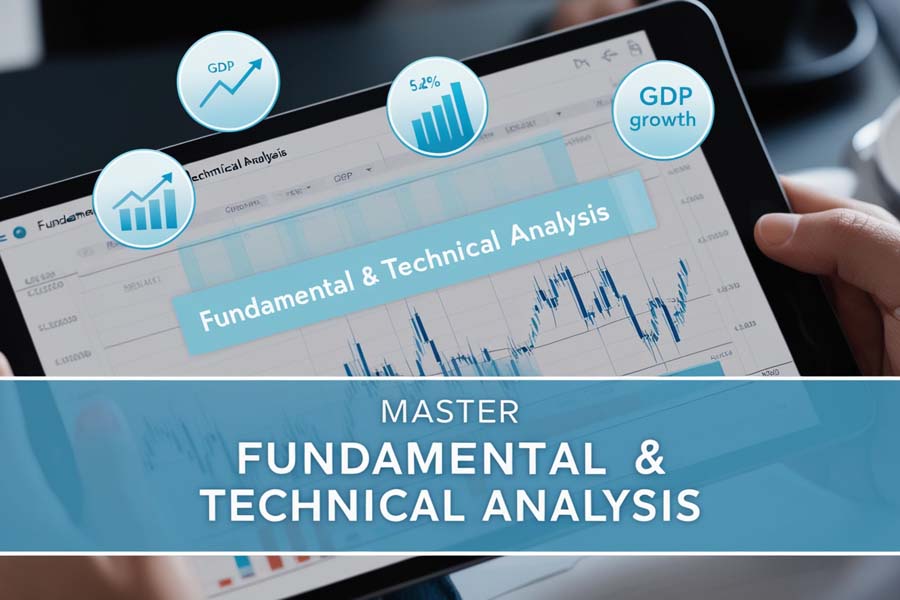
Effective long term forex trading strategy incorporates both fundamental and technical analysis to provide a comprehensive view of the market.
Fundamental Analysis
Fundamental analysis involves evaluating economic indicators, political events, and overall market conditions to determine the intrinsic value of a currency. Key factors include:
- Economic Indicators: GDP growth, employment rates, and inflation data provide insights into a country’s economic health. For example, a higher GDP growth rate typically strengthens a country’s currency as it attracts foreign investment.
- Interest Rates: Central bank policies significantly influence currency values. Higher interest rates offer lenders a better return relative to other countries, attracting foreign capital and causing the currency to appreciate.
- Geopolitical Events: Political stability, trade agreements, and geopolitical tensions can impact investor confidence and currency strength. For instance, trade tensions between major economies can lead to currency volatility.
Understanding fundamental factors allows traders to anticipate long-term currency movements based on the underlying economic landscape.
Technical Analysis
Technical analysis focuses on historical price data and trading volumes to predict future market behavior. Essential tools and techniques include:
- Daily and Weekly Charts: These charts provide a broader perspective on price trends and patterns, helping traders identify long-term support and resistance levels.
- Moving Averages:
- 200-Day Moving Average: A key indicator to identify long-term trends. Prices above the 200-day moving average suggest a bullish trend, while prices below indicate a bearish trend.
- 50-Day Moving Average: Often used alongside the 200-day to confirm trend direction or signal potential reversals.
- Trend Lines and Channels: Help visualize the direction and strength of price movements, aiding in the identification of breakout points.
- Support and Resistance Levels: Indicate potential price reversal points based on historical price behavior, providing strategic entry and exit points.
Using technical indicators in conjunction with fundamental analysis provides a comprehensive view of the market, enhancing the accuracy of trading decisions.
Popular Long-Term Trading Strategies
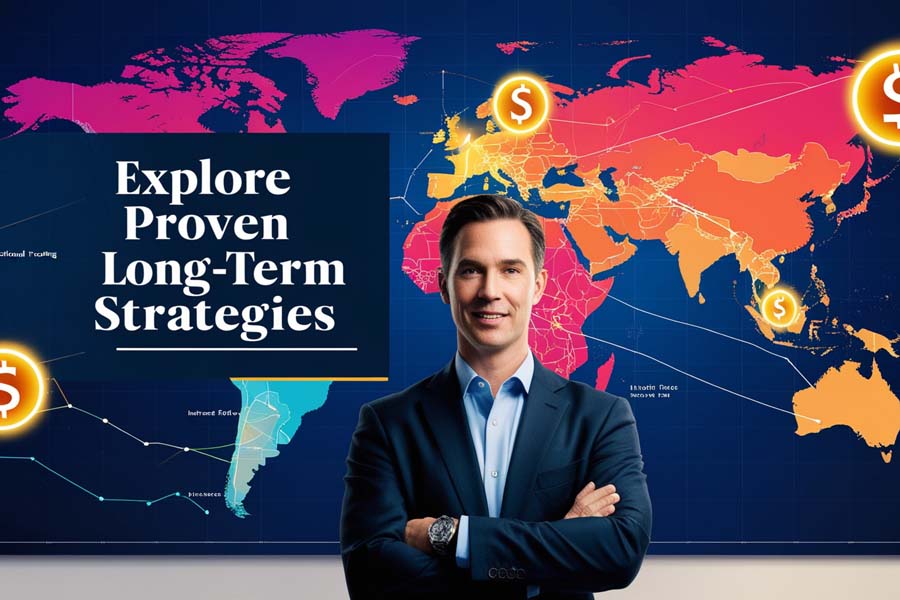
Several strategies are particularly well-suited for a long term forex trading strategy. Here are some of the most effective ones:
Positional Trading Explained
Positional trading involves holding positions for an extended period, typically weeks to months, to capitalize on long-term trends. This strategy requires minimal daily monitoring, making it ideal for traders who prefer a hands-off approach.
Key Features:
- Trend Analysis: Focuses on identifying and following major market trends.
- Minimal Trading Frequency: Fewer trades compared to short-term strategies, reducing transaction costs.
- Patience: Requires waiting for significant market movements to realize profits.
Positional trading allows traders to benefit from significant market movements without the need for constant market observation.
Supply and Demand Zones
Identifying supply and demand zones involves recognizing areas where the price has historically found support (demand) or resistance (supply). These zones indicate potential entry and exit points based on the likelihood of price reversals.
- Demand Zones: Areas where buying pressure exceeds selling pressure, leading to price increases. Traders look to buy in these zones expecting the price to rise.
- Supply Zones: Areas where selling pressure exceeds buying pressure, leading to price decreases. Traders look to sell in these zones expecting the price to fall.
Implementation Tips:
- Identify Historical Zones: Use past price data to locate significant support and resistance levels.
- Confirm with Volume: Higher trading volumes in these zones can confirm the strength of supply or demand.
- Combine with Other Indicators: Enhance accuracy by using moving averages or trend lines alongside supply and demand zones.
Trading based on supply and demand zones helps traders enter and exit positions at optimal points, maximizing potential profits.
Relative Real Interest Rates
Comparing interest rates between countries can predict currency movements. Higher real interest rates (interest rates adjusted for inflation) typically attract foreign capital, leading to currency appreciation, while lower rates may result in depreciation.
How It Works:
- Interest Rate Differentials: Analyze the difference in real interest rates between two countries. A higher real interest rate in one country relative to another can strengthen its currency.
- Economic Fundamentals: Consider other economic factors that may influence interest rates, such as inflation and economic growth.
Example:
- If the real interest rate in Country A is 3% and in Country B is 1%, investors may prefer to hold assets in Country A, increasing demand for its currency and causing appreciation.
Utilizing relative real interest rates provides insight into potential currency strength, aiding in long-term trading decisions.
Use of the 200-Day Moving Average
The 200-day moving average is a widely used indicator to identify long-term trends. When the price is above the 200-day moving average, it signals a bullish trend, while a price below indicates a bearish trend.
- Bullish Signals: Buy when the price crosses above the 200-day moving average, indicating a potential upward trend.
- Bearish Signals: Sell when the price crosses below the 200-day moving average, indicating a potential downward trend.
Advantages:
- Trend Confirmation: Helps confirm the direction of the long-term trend.
- Support and Resistance: Acts as dynamic support in an uptrend and resistance in a downtrend.
Incorporating the 200-day moving average into your strategy provides a reliable indicator of the overall market trend, aiding in making informed trading decisions.
Developing a Long-Term Trading Plan

Implementing a successful long term forex trading strategy involves several well-defined steps:
Researching and Selecting Currency Pairs
Choose currency pairs that align with your trading goals and risk tolerance. Focus on major pairs like EUR/USD, GBP/USD, and USD/JPY for their liquidity and stability. Additionally, consider cross pairs and emerging market currencies to diversify your portfolio.
Considerations:
- Liquidity: Major pairs typically have higher liquidity, reducing the risk of large price swings.
- Economic Stability: Pairs involving economically stable countries tend to have more predictable movements.
- Correlation: Be aware of how different currency pairs correlate to manage diversification effectively.
Selecting the right currency pairs is crucial for minimizing risk and maximizing potential returns in your long-term trading strategy.
Monitoring Economic Conditions and Indicators
Stay informed about global economic conditions and key indicators that influence currency values. Regularly review economic reports, central bank announcements, and geopolitical developments to anticipate market movements.
Key Indicators to Monitor:
- GDP Reports: Indicate the economic growth of a country.
- Employment Data: Reflect the labor market’s health.
- Inflation Rates: Influence central bank policies on interest rates.
- Central Bank Meetings: Decisions on interest rates and monetary policies can significantly impact currency values.
- Geopolitical Events: Elections, trade negotiations, and conflicts can create volatility.
Continuous monitoring of economic conditions ensures that your trading strategy remains aligned with the prevailing market trends and conditions.
Setting Clear Entry and Exit Points
Define specific criteria for entering and exiting trades based on your analysis. Clear entry and exit points help eliminate emotional decision-making and ensure disciplined trading.
- Entry Points: Conditions under which you will initiate a trade (e.g., price crossing above the 50-day moving average or entering a supply zone).
- Exit Points: Conditions under which you will close a trade (e.g., reaching a target profit level or triggering a stop-loss).
Example:
- Entry: Buy EUR/USD when it crosses above the 200-day moving average with a confirmed bullish trend.
- Exit: Sell EUR/USD when it reaches a predetermined profit target or if it falls below the 200-day moving average.
Having predefined entry and exit points enhances the consistency and effectiveness of your trading strategy.
Importance of Setting Stop-Loss Orders and Profit Targets
Implementing stop-loss orders and setting profit targets are essential risk management techniques. Stop-loss orders limit potential losses by automatically closing a trade at a predetermined price, while profit targets ensure you secure gains when your desired profit level is reached.
Best Practices:
- Stop-Loss Placement: Set stop-loss orders based on technical levels such as support and resistance or a fixed percentage of your trading capital.
- Profit Targets: Define realistic profit targets based on historical price movements and market analysis.
- Risk-Reward Ratio: Aim for a favorable risk-reward ratio (e.g., 1:2), ensuring that potential profits outweigh potential losses.
Using stop-loss orders and profit targets protects your capital and ensures you lock in profits systematically.
Psychological Factors in Long-Term Trading
Emotional control is crucial for maintaining a successful long term forex trading strategy. Traders often face psychological challenges that can impact their decision-making process:
Managing Emotions and Psychological Challenges
- Fear: Can prevent you from entering trades or cause premature exits, resulting in missed opportunities or losses. For example, fear of losing capital may lead to closing a position too early before it reaches its potential.
- Greed: May lead to overtrading or holding positions too long in pursuit of excessive profits, increasing risk exposure. Greed-driven decisions can result in significant losses if the market turns against your position.
- Overconfidence: After a series of successful trades, traders might ignore risk management rules, leading to significant losses. Overconfidence can result in taking larger risks than advisable.
Strategies to Manage Emotions:
- Maintain a Trading Journal: Document your trades and emotional state to identify and address recurring emotional patterns.
- Set Realistic Goals: Avoid setting unattainable profit targets that can lead to frustration and impulsive decisions.
- Practice Mindfulness: Techniques such as meditation can help improve emotional resilience and decision-making under pressure.
Managing these emotions and psychological challenges is essential for maintaining discipline and adhering to your long-term trading plan.
The Importance of Patience and Discipline in Trading Decisions
Patience allows traders to wait for optimal trading opportunities based on their analysis, while discipline ensures they follow their trading plan without deviating due to emotional impulses.
Key Aspects:
- Waiting for Confirmation: Do not rush into trades without confirming signals through multiple indicators or analysis methods.
- Sticking to the Plan: Adhere strictly to your trading plan, including entry and exit points, regardless of short-term market fluctuations.
- Avoiding Impulsive Decisions: Refrain from making spontaneous trades based on rumors or unverified information.
Cultivating patience and discipline helps traders stay committed to their strategy, enhancing long-term success.
Case Studies and Examples
Examining historical examples of successful long-term trades can provide valuable insights and inspiration for your trading strategy.
George Soros and the British Pound
One of the most renowned long-term trades was executed by George Soros in 1992. Anticipating the British pound’s vulnerability due to economic pressures and high interest rates, Soros shorted the pound, betting on its devaluation. His strategy paid off handsomely when the pound was forced out of the European Exchange Rate Mechanism (ERM), resulting in significant profits.
George Soros’s successful long-term trade highlights the importance of thorough fundamental analysis and the ability to act decisively on informed predictions.
The USD/EUR Long-Term Trend
Over the past decade, the USD/EUR pair has experienced significant fluctuations driven by differing economic policies, interest rate changes, and geopolitical events. Long-term traders who focused on these fundamental factors were able to capitalize on the sustained trends, achieving consistent returns.
The USD/EUR case demonstrates how long-term traders can benefit from understanding and anticipating major economic shifts.
Historical Example: Swiss National Bank and the Swiss Franc
In January 2015, the Swiss National Bank (SNB) unexpectedly removed the peg of the Swiss franc to the euro, causing the franc to soar. Traders who anticipated potential pressure on the franc due to economic indicators and geopolitical tensions were able to profit from the rapid appreciation by holding long-term positions.
This example underscores the importance of staying informed about central bank policies and economic indicators to anticipate major currency movements.
Pro Tips for Advanced Traders
For those looking to elevate their long term forex trading strategy, here are some advanced tips to consider:
Leverage Economic Calendars
Stay ahead of market-moving events by utilizing economic calendars. These tools provide schedules of upcoming economic releases, central bank meetings, and geopolitical events that can influence currency prices.
Benefits:
- Preparation: Allows traders to prepare for potential volatility.
- Strategic Planning: Helps in timing trades around significant events.
Incorporate Algorithmic Trading
Advanced traders can leverage algorithmic trading to automate their strategies. By using predefined criteria and algorithms, you can execute trades with precision and speed, minimizing emotional interference.
Advantages:
- Consistency: Ensures trades are executed based on logic rather than emotion.
- Efficiency: Can process and act on large amounts of data quickly.
Monitor Market Sentiment
Understanding market sentiment helps anticipate price movements based on collective trader behavior. Utilize sentiment indicators and news analysis to gauge the prevailing mood in the market.
Tools:
- Commitment of Traders (COT) Reports: Provide insights into the positioning of large traders.
- Sentiment Indicators: Tools like the RSI (Relative Strength Index) can indicate overbought or oversold conditions.
Optimize Your Trading Tools
Invest in high-quality trading platforms and analytical tools to enhance your trading efficiency. Features like real-time data, advanced charting capabilities, and automated alerts can provide a competitive edge.
Recommendations:
- MetaTrader 5 (MT5): Offers comprehensive trading tools and customizable features.
- Automated Alerts: Set up alerts for specific price movements or indicator signals.
These pro tips empower advanced traders to refine their strategies and achieve higher levels of success in the forex market.
Opofinance Services: Your Trusted Forex Trading Partner
When implementing a long term forex trading strategy, partnering with a reliable broker is paramount. Opofinance stands out as an ASIC regulated forex broker, offering a secure and user-friendly trading environment. Key features include:
- Social Trading Service: Connect with and learn from successful traders through our social trading platform, enhancing your trading strategies and performance.
- MT5 Brokers List: Officially featured on the MT5 brokers list, Opofinance provides access to the advanced MetaTrader 5 platform, renowned for its comprehensive trading tools and customizable features.
- Safe and Convenient Deposits and Withdrawals: Enjoy a variety of secure and efficient payment methods, ensuring seamless transactions without hassle.

Choose Opofinance as your forex broker to experience unparalleled support and innovative trading solutions tailored to your long-term trading needs.
Conclusion
Developing a robust long term forex trading strategy is essential for achieving consistent profitability and navigating the complexities of the forex market. By integrating fundamental and technical analysis, implementing effective risk management, and maintaining emotional discipline, traders can enhance their chances of long-term success. Additionally, leveraging advanced trading techniques and partnering with a reputable broker like Opofinance can further optimize your trading performance.
Key Takeaways
- Patience and Discipline: Essential traits for maintaining focus and adhering to your trading plan.
- Comprehensive Trading Plan: Outlines your goals, strategies, and risk management rules.
- Fundamental and Technical Analysis: Combine both to gain a comprehensive market understanding.
- Risk Management: Protect your capital through position sizing, stop-loss orders, and diversification.
- Emotional Discipline: Stay focused and adhere to your trading plan to mitigate psychological biases.
- Advanced Strategies: Utilize economic calendars, algorithmic trading, and market sentiment analysis for enhanced performance.
- Reliable Broker Partnership: Choose a regulated broker like Opofinance to ensure a secure and supportive trading environment.
How do geopolitical events impact long term forex trading strategies?
Geopolitical events such as elections, trade negotiations, and conflicts can significantly influence currency values by affecting investor confidence and economic stability. Long-term traders monitor these events to anticipate potential shifts in currency trends and adjust their strategies accordingly.
What role does economic growth play in long term forex trading?
Economic growth indicators, such as GDP, employment rates, and industrial production, reflect a country’s economic health. Strong economic growth typically strengthens a country’s currency, providing long-term traders with opportunities to capitalize on upward trends.
How can long-term traders effectively manage currency pair volatility?
Long-term traders manage volatility by diversifying their portfolios across multiple currency pairs, using appropriate position sizing, and implementing robust risk management strategies such as stop-loss orders. This approach minimizes the impact of sudden market swings on their overall portfolio.







